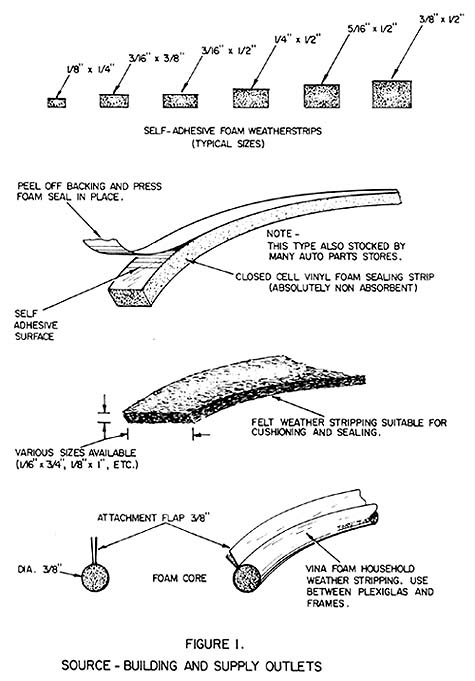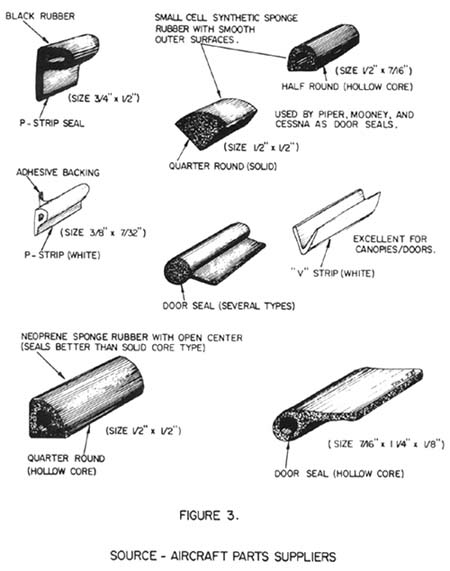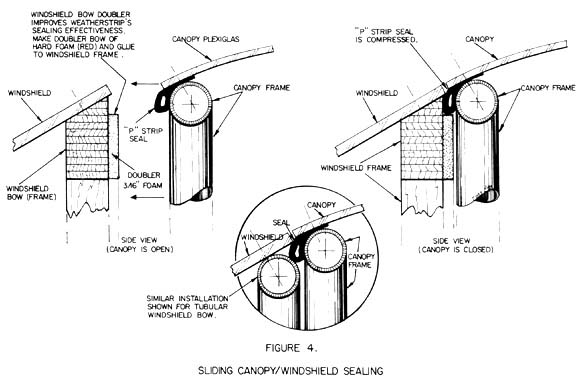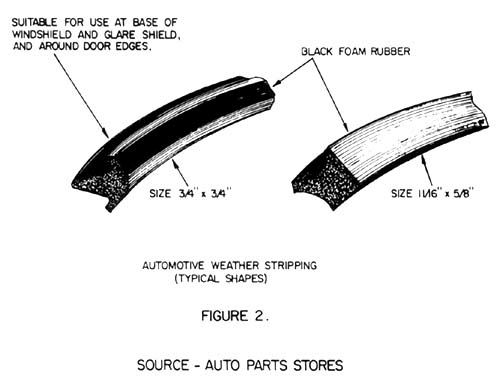Weatherstripping
By Tony Bingelis (originally published in EAA Sport Aviation, November 1987)
In the final drive to complete and fly your airplane for the first time, a few small details are often overlooked or b slighted. Weatherstripping is one such detail. Of course, weatherstripping is not at all a flight safety matter, but still it is rather important that your canopy/windshield installation be weatherstripped for that first flight. Why? Well, it may all be mental with me, but I always get the feeling that my airplane is safer and flies better when I don't hear all of the unbridled commotion and noise of the engine, propeller and the slipstream. Silly? Maybe so, but for that first test flight the added quietness can be reassuring.
Anyway, as you know, autos, like airplanes, are weatherstripped primarily to keep out or to reduce the amount of wind noise. Apparently manufacturers place great stock in the belief that the auto buying public is impressed by the luxurious quietness of a new model car. Car makers strive, therefore, through insulation and weatherstripping, to provide the quietest car possible for the money. Well, if noise reduction is considered worthwhile in a vehicle moving at 60 mph, think how much more important weatherstripping becomes at speeds well over 100 mph . . . and how about in an airplane capable of cruising at 200 mph? Wind noise like any other kind of sustained loud noise can be damaging to your hearing.
When you stop to think about it, wind noise is not the only reason for weatherstripping. A good job of weatherstripping can reduce drag and also keep your cabin dry - whether the aircraft is tied down in the rain, or you happen to fly it through a shower.
As many airplane owners can tell you, being parked in the rain is not the only way you can get your cabin soaked. Everytime you wash the airplane with a hose you are taking the chance that water will get into the cabin, unless you have the windshield and windows or canopy well sealed.
Weatherstripping is so easy to install that no builder should put up with a leaky airplane and a cabin that is riddled with noise producing air leaks in flight.
To remedy that shortcoming all you need do is to select a type of weatherstrip that will fit well in the areas you want sealed, and then stick the strips down around the edges of windshield and canopy, or door, with a suitable adhesive. There is a little more to it than that, of course. For example, the effectiveness of the weatherstrip you install will depend largely on the type selected for use in the particular location you are trying to seal.
Naturally, you would not expect a single type of weatherstrip to work equally as well every place. On the other hand, you should not have to modify a weatherstrip to make it fit your particular need. There are so many kinds and shapes of weatherstripping available from numerous sources that you should be able to find exactly what you need.
SOURCES FOR WEATHERSTRIPPING
1. Building and Supply Outlets
These, as well as lumber and hardware discount stores, stock common varieties of weatherstripping materials designed primarily for use in insulating homes and other structures. Surprisingly, some of these weatherstripping materials are claimed to be fire resistant. Of the several types to be found in the building and supply outlets, the type best suited for aircraft installations is the flat spongy rectangular vinyl foam rubber strip variety with an adhesive backing (see Figure 1). This kind of weatherstripping is sold in several widths and thicknesses.
These closed cell foam rubber strips are excellent for use with a "flip-over" type of canopy because the foam is very soft and non-absorbent. It will compress down to practically nothing. And it can conform to fit narrow gaps and minor surface irregularities, and still do a good job of keeping out wind noise, dust, rain and water.
2. Auto Parts Stores - Auto parts stores are almost as numerous as drive-in grocery stores, and most of them stock weatherstripping materials manufactured especially for the auto industry. This makes most any auto parts store a very convenient local source for your weatherstripping materials.
Automotive weatherstrips are designed, primarily, for sealing around automobile doors. These sealing strips are made of a black rubber material that is a bit larger in cross section than most other kinds of weather strips. The automotive type of seal strips is also somewhat heavier and more expensive than the "lumberyard" variety. Nevertheless, due to their shapes, some are excellent for use around the base of a windshield and canopy. And, being larger in cross section, such a seal can hide the raw edges of the glareshield upholstery and, at the same time, reduce vibration in the windshield while enhancing its rigidity.
3. Aircraft Supply Sources - This third source for weatherstripping materials includes commercial aviation supply houses, local airport parts departments, and those selling directly to the amateur aircraft builders. These aviation oriented outlets generally have a larger selection of the type weatherstripping manufactured for the aviation industry. As a consequence, you might expect to find their prices a good bit higher . . . but not always.
In the interest of economy, you might first try to make one of the locally available household variety of self-adhesive weather strips take care of your weatherstripping needs. On the other hand, if you do have an unusually shaped area to be sealed you may have to consider ordering one of the less commonly available seal strips illustrated.
(See Figure 3)
ABOUT WEATHERSTRIP ADHESIVES
It is very annoying to find one end of your weather trips pulled loose and dangling before your eyes. This most frequently happens on hot days after your aircraft has been soaking in the blazing sun on the ramp. The problem may be due, in part, to the use of an inferior adhesive and not your workmanship.
As for suitable adhesives, you really don’t have too many to choose from unless you are willing to experiment with new unproven adhesives. For a weatherstrip adhesive to be effective, it should be capable of adhering to vinyl foam and rubber seal strips, and to a variety of attachment surfaces (wood, fiberglass, metal, etc.). In addition, it must dry or cure rather quickly or you may have to sleep in your airplane while holding that new weatherstripping in place until the adhesive sets.
The best known and most widely used weatherstrip adhesives are a couple of 3M products. One is the more economical, 3M Weatherstrip Adhesive, which is black in color and ordinarily comes in a 5 oz. tube (No. 8011). The other is an amber (clear) adhesive, 3M Super Weatherstrip Adhesive (No. 8001). It, too, is sold in 5 oz. tubes. I don't know how much better it is, but it does cost almost twice as much as the black adhesive.
Some builders use Scotchbrand Contact Cement with good results on a variety of surfaces. Others don't fair as well. Hardly anyone recommends the use of a spray adhesive for attaching weatherstripping so that further limits your choices. There may be a number of other products that can effectively attach weatherstripping but, as far as I know, few are commonly available in all parts of the country. On the other hand, the 3M weatherstrip adhesives can be found in virtually all major auto parts stores.
INSTALLATION TIPS
You only have a few things to keep in mind. Be sure that the surface to which the weatherstrip is to be attached is clean and free of oil, grease, wax and silicone contamination.
By all means follow instructions for the use of the adhesive you are using. If it says coat both the seal and the surface to which it is to be attached - do so. Likewise, if the instructions say to wait a bit and allow the adhesive to become tacky, you better believe it.
See that the ends of your weatherstrip installation meet and join closely at the lowest point of the windshield, canopy or door being sealed. This is important if you hope to keep water from penetrating the weatherstripping and finding its way into the cabin. (see Figure 4)
Don't forget to seal around your canopy or door latch if it is located on top.
Try to install the weatherstrips inside the canopy, door, or windshield so that they don't protrude, or show, externally. Installing weatherstripping otherwise will result in a drag producing installation.
Where the structure has sufficient width, two parallel weatherstrips may be installed to produce the most effective seal against wind noise. One of the strips should be attached to the aircraft structure and the other to the opening component (canopy, windshield, door) you want to seal (see Figure 2).
MAINTAINING YOUR WEATHERSTRIPPING
Continuous exposure to weather elements will ultimately cause weatherstrips to harden, become brittle and finally break, or become separated from their point of attachment. When the weatherstripping reaches such a state, it should be replaced. Attempting to repair it by splicing in a short section is not worth the effort.
Another ailment that weatherstripping suffers from is stickiness. The heat of the summer sun occasionally causes seal strips to become sticky, making doors and canopies difficult to open. Sometimes the sticky seals tend to pull away from their attachment points further compounding an annoying condition.
Solve this problem by lightly rubbing a cotton swab or a small cloth wetted with silicone spray along the rubber seal strip. This will eliminate the stickiness.
Do not spray silicone directly onto the weatherstrips as the overspray will contaminate all adjacent areas. As you know, you cannot paint over any surface that has silicone on it . . . it just won't stick. And, furthermore, the invisible silicone is extremely difficult to remove.
Incidentally, before you give your weatherstrips the silicone treatment to eliminate stickiness, you should resecure any portion of the weatherstripping that may have been pulled loose.




